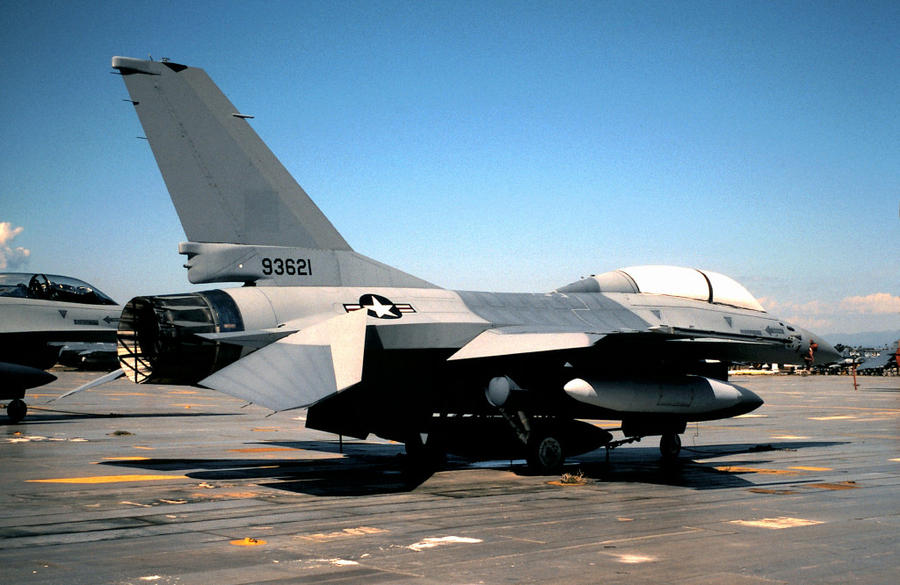Cont...
In the 1990s, Pakistan was on the receiving end of the Pressler Amendment, a piece of American legislation designed to stop the Pakistani military from developing nuclear weapons. In 1988-1989 the Pakistan Air Force had hoped to build a substantial portion of its operational fleet around the F-16A/B, but Pressler made Pakistan’s abandonment of its nuclear program a prerequisite to the delivery of those aircraft. 28 of the 71 ordered F-16s were built, and until the early 2000s, they had been kept in storage in the U.S. The U.S Air Force (USAF) and U.S Navy took ownership of them, with the latter using them as aggressor aircraft for training. The 14 USAF aircraft were eventually delivered to the PAF as part of George Bush Jr’s efforts to win over the Pakistani military’s support in the War on Terror. But in the interim period the PAF had to acquire surplus Mirage III and V aircraft from Australia and France as a means to help soothe the gap left by the non-delivered F-16A/Bs. And while it did try to acquire the Mirage 2000 from France in lieu of the F-16s, public corruption and poor public finances caused those efforts to collapse.

One of the embargoed PAF F-16s that was assigned to the U.S Air Force, this unit was later transferred to Pakistan.
Although the idea of manufacturing modern jet fighters in Pakistan was explored since as far back as the 1950s, the notion gained serious momentum in the late 1980s when the Sabre II program was studied.
At that time the PAF was looking to replace its ageing F-6s (Chinese variant of the Soviet MiG-19) with a modern low-cost multirole fighter. The idea basically revolved around taking the Chinese F-7M (a MiG-21 variant) and heavily modifying it to fit a Pratt & Whitney or General Electric turbofan engine and a powerful radar (reportedly the AN/APG-66, i.e. the radar used on the F-16 at the time).
A render of the Sabre-II program. The PAF requested Grumman to come up with a design using the Chengdu F-7M as the basis.
The Sabre II was envisaged as a collaboration between the PAF, Chengdu Aircraft Corporation (CAC) and Grumman Aerospace.
It was hoped that the U.S would supply the turbofan engine, radar and avionics suite. In the end the project was canned, primarily as a result of U.S sanctions, but also potentially the reality that the design might have been too limited for long-term use. At the end of the day the Sabre II was still based on the F-7, which in turn is a variant of the 1950s-era MiG-21. But with the Pressler-sanctions taking their toll on the PAF’s F-16 fleet and cutting the PAF from acquiring spare parts and attrition replacements for its most modern fighter, urgency for a locally-sourced fighter became critical. In 1994 the PAF accepted an offer from the China National Aero-Technology Import and Export Corporation (CATIC) to jointly-develop a new lightweight multirole fighter, then known as the Super-7.
The Super-7’s design was finalized in 1999, and sometime later, it was decided by the PAF to decouple the program’s airframe development from the development of its electronics (e.g. radar). This was a significant change in that the development of avionics or radars was no longer dependent on the airframe, and vice-versa. This helped keep matters fluid in that should a new kind of system were to arise on the electronics front (where the industry moves quickly), the PAF could readily incorporate those shifts onto the platform without a major lag time. This helped ensure that the final product would be in line with the expectations of the day it rolls out, not the day when it is finalized on the drawing board.
A mock-up of the Super-7 released some time after the design was finalized in 1999.
The selected engine was the Klimov RD-93 from Russia, a variant of the RD-33 used on the MiG-29. The PAF was and still is satisfied with its choice, and it may hope that this avenue will continue by including the more powerful RD-93MA. Western turbofans were considered, but the risk of sanctions and reality of weak public finances on Pakistan’s part must have firmly excluded those routes. China is also developing its own engines for the fighter, most notably the WS-13
(and possibly WS-17 if is indeed a different program from the WS-13), but I doubt the PAF would select them when it can still acquire the RD-93.
The first prototype rolled out and flew in 2003, and the Super-7 was given a new name – JF-17 Thunder. Since then the fighter had seen a few significant changes to its airframe. I will explore these changes in greater detail in another article, but in short, the JF-17’s airframe saw numerous aerodynamic improvements, most notably to the leading edge root extensions (LERX) and air intakes.
Actual production-batch JF-17s. Notice the altered intakes.
The final electronics suite (i.e. radar, avionics, EW/ECM, etc.) was drawn from Chinese vendors such as the
Nanjing Research Institute of Electronics Technology (NRIET). I will go into the specifics of each current (and future) subsystem in a subsequent article, but needless to say, the JF-17 Block-I currently in service with the PAF is equipped with a modern radar and avionics suite. Since its induction with the No. 26 squadron in February 2010, the JF-17 has (alongside the new and upgraded F-16s) infused the PAF with greatly improved air-to-air (A2A) and air-to-surface (A2S) combat capabilities.







.jpg)


